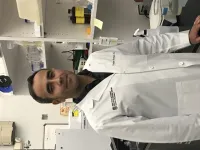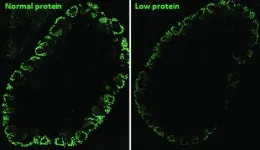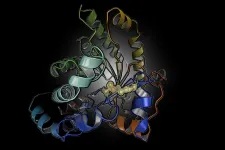(Press-News.org) At the beginning of the COVID-19 pandemic, intense social distancing and lockdown measures were the primary weapon in the fight against the spread of SARS-CoV-2, but they came with a monumental societal burden. New research from the Center for the Ecology of Infectious Diseases and the College of Public Health at the University of Georgia explores if there could have been a better way.
Published in the journal Proceedings of the Royal Society B, the research analyzes more palatable alternatives to the kind of social distancing mandates that threw a wrench at how businesses, schools and even family gatherings work. The alternatives--widespread testing, contact tracing, quarantines, certification for non-infected people and other public health policy measures--can slow the spread when combined together, but only with significant investments and broad public compliance.
"I understand why government leaders quickly enacted strict social distancing mandates as the COVID-19 pandemic was rapidly spreading in 2020," said lead author John Drake, director of the Center for the Ecology of Infectious Diseases and Distinguished Research Professor in the Odum School of Ecology. "This was the best that we could do at the time. However, school and workplace closures, gathering limits and shelter-in-place orders have had extreme economic consequences. These are harsh, and we really need to find alternative solutions."
Drake worked with other researchers to develop two models. One targeted how to find infected people to limit transmission through active case finding (through testing of at-risk individuals), thorough contact tracing when cases arise, and quarantines for people infected and their traced contacts.
The second model focused on a strategy of limiting exposure by certifying healthy individuals.
"Each model was tested independently and in combination with general non-pharmaceutical interventions (NPIs)," said co-author Kyle Dahlin, a postdoctoral associate with the center.
For this study, those interventions were defined as behavioral or generalized interventions that can be broadly adopted, such as wearing a face mask, hand washing, enhanced sick leave, micro distancing and contactless transactions.
"When we ran the model to evaluate the effectiveness of only using social distancing measures, like workplace closures, after the onset of the first wave, approximately half of the population eventually became infected," said study co-author Andreas Handel, associate professor of biostatistics and epidemiology in UGA's College of Public Health who helped design the models. "When we combined social distancing with general interventions, SARS-CoV-2 transmission was slowed, but not enough for complete suppression."
When they tested the model that actively looked for infection, they found that active case-finding had to identify approximately 95% of infected persons to stop viral spread. When combined with NPIs, like face masks, the fraction of active cases that needed to be located dropped to 80%. Considering that during the first wave of the pandemic in 2020, only 1% to 10% of positive cases were found, such an approach by itself wouldn't work.
The researchers also determined that adding contact tracing and quarantine to active case finding and general NPIs did not drastically change the model's success.
The model that targeted healthy people to limit exposure determined that to successfully control viral spread, SARS-CoV-2 test validity had to occur within a very narrow window of seven to 10 days with a waiting time of three days or less, and NPIs had to be strictly adopted. Otherwise, a large outbreak would occur.
Pej Rohani, Regents' and Georgia Athletic Association Professor of Ecology and Infectious Diseases in the Odum School and College of Veterinary Medicine, said that the models' conclusions indicated the need for continued research.
"These models are important because infectious disease ecologists and epidemiologists need to understand how SARS-CoV-2 transmission can be reduced using measures that do not have extreme societal consequences," he said.
The CEID's research highlighted the importance of a robust and widespread testing program, the general adoption of NPIs like face masks, and targeted measures to globally control the ongoing pandemic. These approaches are still extremely important as vaccines continue to be distributed.
INFORMATION:
This research was funded by the National Institutes of Health under Award Numbers U01GM110744 and R01GM123007 and R01 GM 12480-03S1.
A study published in July 2020 hypothesized a link between the presence of bradykinin, a well-known peptide, and severe cases of COVID-19. Vardan Karamyan, Ph.D., an associate professor and vice chair for the Texas Tech University Health Sciences Center (TTUHSC) Jerry H. Hodge School of Pharmacy Department of Pharmaceutical Sciences, had not previously conducted or evaluated any research related to COVID-19. However, he found the article intriguing because it discussed bradykinin, one of three specific peptides with which his lab has much well-published experience.
The paper received a lot of attention in both the media and scientific literature, but as Karamyan read through it, he felt it failed to address an equally important part of a bigger picture: the likely ...
A new service piloted at Penn Medicine allowed a proportion of patients to avoid hospitalization by providing them with greater support after visiting the emergency department. The vast majority of the patients enrolled in the service - nearly 9 out of 10 - did not need to return to the hospital for care in the month that followed their initial visit. The study was published in Healthcare.
"The culture is shifting where we realize that hospitalization is not always the best option for patients - particularly patients with chronic illness," said one of the study's lead authors, Austin Kilaru, MD, an emergency physician at Penn Medicine. "We need to find better ways of helping patients not just get healthy in a hospital, but stay healthy at ...
Leather is an ever growing multi-billion dollar industry requiring more than 3.8 billion bovine animals - equal to one for every two people on earth - to sustain production each year. And while the products - clothing, shoes, furniture and more - can be quite elegant and durable, the environmental impact of leather production has been severe, leading to deforestation, water and land overuse, environmental pollution, and greenhouse gas emissions.
Researchers at Tufts University School of Engineering set out to find an alternative to leather, with similar texture, flexibility and stiffness, yet focused on materials that are sustainable, non-toxic, and friendly to the environment. It turns out, we have been wearing that material ...
PITTSBURGH, May 5, 2021 - Subtle differences in the shape of the brain that are present in adolescence are associated with the development of psychosis, according to an international team led by neuroscientists at the University of Pittsburgh School of Medicine and Maastricht University in the Netherlands.
In results published today in JAMA Psychiatry, the differences are too subtle to detect in an individual or use for diagnostic purposes. But the findings could contribute to ongoing efforts to develop a cumulative risk score for psychosis that would allow for earlier detection and treatment, as well as targeted therapies. The discovery was made with the largest-ever ...
Besides being underweight, babies born to women whose diet lacked sufficient protein during pregnancy tend to have kidney problems resulting from alterations that occurred while their organs were forming during the embryonic stage of their development.
In a study published in PLOS ONE, researchers affiliated with the University of Campinas (UNICAMP) in the state of São Paulo, Brazil, discovered the cause of the problem at the molecular level and its link to epigenetic phenomena (changes in gene expression due to environmental factors such as stress, exposure to toxins or malnutrition, among others).
According to the authors, between 10% and 13% of the world population ...
Researchers from the University of Liverpool have shown the potential of repurposing an existing and cheap drug into a long-acting injectable therapy that could be used to treat Covid-19.
In a paper published in the journal Nanoscale, researchers from the University's Centre of Excellence for Long-acting Therapeutics (CELT) demonstrate the nanoparticle formulation of niclosamide, a highly insoluble drug compound, as a scalable long-acting injectable antiviral candidate.
The team started repurposing and reformulating identified drug compounds with the potential for COVID-19 therapy candidates within weeks of the first lockdown. Niclosamide is just one of the drug compounds identified and has been shown to be highly effective against SARS-CoV-2 in a number of laboratory studies.
Using ...
New Johns Hopkins University simulations offer an intriguing look into Saturn's interior, suggesting that a thick layer of helium rain influences the planet's magnetic field.
The models, published this week in AGU Advances, also indicate that Saturn's interior may feature higher temperatures at the equatorial region, with lower temperatures at the high latitudes at the top of the helium rain layer.
It is notoriously difficult to study the interior structures of large gaseous planets, and the findings advance the effort to map Saturn's hidden regions.
"By ...
The incorporation of boron into polycyclic aromatic hydrocarbon systems leads to interesting chromophoric and fluorescing materials for optoelectronics, including organic light-emitting diodes (OLEDS) and field-effect transistors, as well as polymer-based sensors. In the journal Angewandte Chemie, a research team has now introduced a new anionic organoborane compound. Synthesis of the borafluorene succeeded through the use of carbenes.
Borafluorene is a particularly interesting boron-containing building block. It is a system of three carbon rings joined at the edges: two six-membered and one central five-membered ring, whose free tip is the boron atom. While neutral, radical, and cationic (positively ...
Proteins perform a vast array of functions in the cell of every living organism with critical roles in almost every biological process. Not only do they run our metabolism, manage cellular signaling and are in charge of energy production, as antibodies they are also the frontline workers of our immune system fighting human pathogens like the coronavirus. In view of these important duties, it is not surprising that the activity of proteins is tightly controlled. There are numerous chemical switches that control the structure and, therefore, the function of proteins in response to changing environmental conditions and stress. ...
Philadelphia, May 5, 2021--When Luke Terrio was about seven months old, his mother began to realize something was off. He had constant ear infections, developed red spots on his face, and was tired all the time. His development stagnated, and the antibiotics given to treat his frequent infections stopped working. His primary care doctor at Children's Hospital of Philadelphia (CHOP) ordered a series of blood tests and quickly realized something was wrong: Luke had no antibodies.
At first, the CHOP specialists treating Luke thought he might have X-linked agammaglobulinemia (XLA), a rare immunodeficiency syndrome seen in children. However, as the CHOP research team continued investigating Luke's case, they realized Luke's condition was unlike any disease described ...





